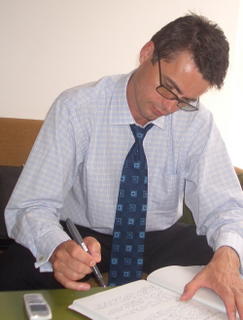
It seems the (not so new) CEO of our Council has spare time on his hands in January - and has strangely developed a writing style from the Clover Moore school. Eyebrows were raised at Council and around town when the op-ed piece below appeared with the CEO's by line. It is quite unusual to see an incumbent government CEO or Director General putting pen to paper to defend political policy of his/her political masters. Perhaps it was a public demonstration of the rededicated loyalty to Clover Moore following those weird SMH Spike rumours of a rift developing. Or more likely an assessment that if the political loner Clover Moore keeps championing light rail then it will never be supported by those at Macquarie Street and Canberra (or Macquarie Bank) with the power and deep pockets to make it reality and not just glossy brochure hype. At the end of the day it should be our political leaders and not mandarins pumping the snake oil. Where is Clover Moore?
To view the City of Sydney consultant's report on an integrated light rail network click here.
Meanwhile bloggers of the right have been in a cyber lather trying to discredit any light rail proposals that threaten their car dependent lifestyles. That right wing thinking blogger Bilious Young Fogey runs the pro bus and pro multinational car company line against Light Rail for Sydney. Backing up the Right is Councillor Michael Lee's brother with his anti light rail - pro bus agenda (note he was the head of Sydney buses) published in the SMH earlier in the week and discredited by letter writers and Clover's nom de plume Mr Seamer.
All aboard the light rail to the future
January 19, 2006
Sydney needs to act on a looming transport crisis before it chokes on its own growth, writes Peter Seamer.
ANYONE who catches a bus during peak hour, and often outside of peak hour, will have experienced the problem of waiting for passengers to board, buses queuing to reach the stop and watching crowded buses sail past.
Sydney's mix of public and private transport systems - heavy rail, buses and a growing clutter of cars and trucks - is approaching crisis point.
The experience already this century shows the city is not coping with the exponential growth in traffic congestion.
Certainly, the provision by the State Government of more train and bus infrastructure at the suburban hubs will help. But of itself that approach offers no convincing answer for the future, especially when the Government's solutions are geared to a 2017 time frame but are not addressing the pressing problem in the heart of the city, where you have a 350,000 daily workforce and more than 400,000 visitors - and these numbers are growing.
Integrating transport modes is not only an obvious answer, but it can be done.
Light rail 21st-century style is part of how Sydney should tackle a problem that threatens to undermine the viability, vibrancy and versatility of its CBD.
Trams can have an equal or greater capacity along any one line and are much easier and quicker to load, as they can have several doors. They are particularly good for inner-city trips, which are short and require high volumes.
In terms of capacity, the sustainability commissioner, Peter Newman, wrote in the Herald last year: "Roads are also limited by their sheer physical capacity. A road lane can carry about 2500 people an hour; a busway about double that - a level now reached and even exceeded on the busways in the city centre.
"Light rail can carry between 7000 and 10,000 people an hour - which is why this must eventually replace the congested bus services along many corridors - while heavy rail can carry 50,000 people per hour, 20 times the capacity of a roadway."
High-speed buses travelling centimetres from pedestrians along our main city routes are not only dangerous but create other problems. A big city like Sydney needs taxis to be able to load and unload quickly on all of our streets, for example. Bus lanes limit access by taxi, car and bike.
In inner Sydney, such as George Street, often at prime times, many buses run half full to nearly empty because many passengers get off at, say, Central or Sydney University. You therefore need far fewer vehicles than you do with buses. Interchanges work when you have high-density, frequent light rail services.
Light rail has been introduced to more than 100 international cities in the past 10 years. In the Toronto CBD, for example, which has three main sources of co-ordinated public transport - heavy rail, buses and light rail - the system carries 40 per cent more passengers and 30 per cent more boardings per capita at 30 per cent lower cost than Sydney.
Today's light rail has travelled a long way since the Bondi tram.
Importantly, light rail can also be delivered within 18 months of approval. Construction can start before the next state election, with completion soon after.
The City of Sydney has undertaken preliminary investigations into the use of Castlereagh and George streets, and visual mock-ups of these streets identify how they can be accommodated.
Making Sydney increasingly a place for bus "freeways" doesn't answer the increasing problems we will have with transport in central Sydney as early as the next decade.
Every year that goes by without us seriously addressing our transport shortage puts us further behind our competitors in Asia and Europe.
Peter Seamer is chief executive of City of Sydney council.

No comments:
Post a Comment